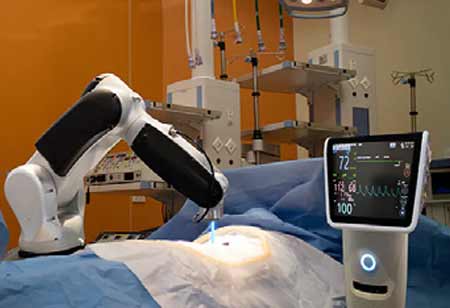Thank you for Subscribing to Healthcare Business Review Weekly Brief

In the Future, Robots Will Replace Wound Care Doctors
Healthcare Business Review
The future of our industry could look vastly different from what it does today—or it might look exactly the same. I don’t have a crystal ball, so it’s hard to tell. While it’s unlikely that robots will replace America’s many talented wound care providers, one thing is for sure: if you’re working in the industry, you better buckle up for an exciting ride.
We have firmly established several key principles in our field: lower extremity amputations are devastating, and wounds are often the primary cause. Significant effort and funding are directed toward preventing this debilitating outcome. The best wound care departments across the country have responded to amputation statistics by building multidisciplinary teams comprised of key provider specialties—the VIP team, if you will—Vascular Surgery, Infectious Disease, and Podiatry.
However, what is less firmly established—or at least not as widely practiced—is the need for modern throughput efforts to support these providers and their treatment strategies. I’d argue that the multidisciplinary care team should extend beyond the providers to include ancillary and administrative hospital support staff. The modern fee-for-service environment demands it, and patients deserve it. To keep the train on the tracks, swift responses to denials require a solid understanding of industry eligibility and utilization guidelines. I encourage those working with me to review our LCD guidelines a few times a year and check NCCI edits every quarter.
Several exciting advancements are driving progress in our industry, including, like everywhere else, the mighty AI movement. Many of the diagnostic and documentation tools we rely on now feature AI interoperability. Wound care terminology is well understood by large language models, and care centers that fail to embrace this level of technology will be left behind.
The multidisciplinary care team extends beyond providers to include the ancillary and administrative staff—because modern healthcare demands it, and patients deserve it
Measurement and analytical technology in our field continues to hit new strides. Several programs now allow wounds to be measured in all three dimensions, and this technology is even available for download on an iPhone. With these advancements, there should soon be no excuse for mismeasuring or mischaracterizing a wound. I have great confidence in the synergy between human expertise and machine learning in wound care.
Telemedicine has been widely accepted across most areas of medicine and therapy but has struggled to gain traction in wound care. I believe this is due to the rise of home-based wound care providers. Wounds often require physical intervention to heal—cleaning, debridement, or the application of wraps or casts. This, along with fluctuations in reimbursement rates for certain skin substitute products, has fueled the growth of this emerging sector. As a result, providers are now incentivized to bring care directly to patients in underserved areas.
Last but certainly not least, we cannot overlook the often misunderstood companion to effective wound care—Hyperbaric Oxygen Therapy. Proper utilization of this powerful treatment will remain a cornerstone of any serious wound care program. I’m grateful for the Undersea and Hyperbaric Medical Society and its continued efforts to produce valuable research that drives our industry forward.
While I don’t have a crystal ball, it’s clear that clinical and reimbursement dynamics are shaping the future of our industry and practice.









